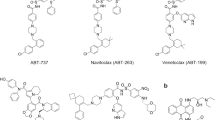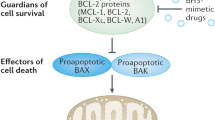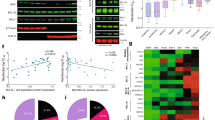Abstract
Proteins in the Bcl-2 family are central regulators of programmed cell death1, and members that inhibit apoptosis, such as Bcl-XL and Bcl-2, are overexpressed in many cancers and contribute to tumour initiation, progression and resistance to therapy2. Bcl-XL expression correlates with chemo-resistance of tumour cell lines3, and reductions in Bcl-2 increase sensitivity to anticancer drugs4 and enhance in vivo survival5. The development of inhibitors of these proteins as potential anti-cancer therapeutics has been previously explored6,7,8,9,10,11,12,13,14,15, but obtaining potent small-molecule inhibitors has proved difficult owing to the necessity of targeting a protein–protein interaction. Here, using nuclear magnetic resonance (NMR)-based screening, parallel synthesis and structure-based design, we have discovered ABT-737, a small-molecule inhibitor of the anti-apoptotic proteins Bcl-2, Bcl-XL and Bcl-w, with an affinity two to three orders of magnitude more potent than previously reported compounds7,8,9,10,11,12,13,14,15. Mechanistic studies reveal that ABT-737 does not directly initiate the apoptotic process, but enhances the effects of death signals, displaying synergistic cytotoxicity with chemotherapeutics and radiation. ABT-737 exhibits single-agent-mechanism-based killing of cells from lymphoma and small-cell lung carcinoma lines, as well as primary patient-derived cells, and in animal models, ABT-737 improves survival, causes regression of established tumours, and produces cures in a high percentage of the mice.
This is a preview of subscription content, access via your institution
Access options
Subscribe to this journal
Receive 51 print issues and online access
$199.00 per year
only $3.90 per issue
Buy this article
- Purchase on Springer Link
- Instant access to full article PDF
Prices may be subject to local taxes which are calculated during checkout




Similar content being viewed by others
References
Daniel, N. N. & Korsmeyer, S. J. Cell death: critical control points. Cell 116, 205–219 (2004)
Kirkin, V., Joos, S. & Zörnis, M. The role of Bcl-2 family members in tumorigenesis. Biochim. Biophys. Acta 1644, 229–249 (2004)
Amundson, S. A. et al. An informatics approach identifying markers of chemosensitivity in human cancer cell lines. Cancer Res. 60, 6101–6110 (2000)
Reed, J. C. Promise and problems of Bcl-2 antisense therapy. J. Natl Cancer Inst. 89, 988–990 (1997)
Letai, A., Sorcinelli, M. D., Beard, C. & Korsmeyer, S. J. Antiapoptotic Bcl-2 is required for maintenance of a model leukemia. Cancer Cell 6, 241–249 (2004)
Klasa, R. J., Gillum, A. M., Klem, R. E. & Frankel, S. R. Oblimersen Bcl-2 antisense: facilitating apoptosis in anticancer treatment. Antisense Nucleic Acid Drug Dev. 12, 193–213 (2002)
Kutzki, O. et al. Development of a potent Bcl-XL antagonist based on α-helix mimicry. J. Am. Chem. Soc. 124, 11838–11839 (2002)
Tzung, S.-P. et al. Antimycin A mimics a cell-death-inducing Bcl-2 homology domain 3. Nature Cell Biol. 3, 183–191 (2001)
Becattini, B. et al. Rational design and real time, in-cell detection of the proapoptotic activity of a novel compound targeting Bcl-XL . Chem. Biol. 11, 389–395 (2004)
Kitada, S. et al. Discovery, characterization, and structure—activity relationships studies of proapoptotic polyphenols targeting B-cell lymphocyte/leukemia-2 proteins. J. Med. Chem. 46, 4259–4264 (2003)
Wang, J.-L. et al. Structure-based discovery of an organic compound that binds Bcl-2 protein and induces apoptosis of tumor cells. Proc. Natl Acad. Sci. USA 97, 7124–7129 (2000)
Degterev, A. et al. Identification of small-molecule inhibitors of interaction between the BH3 domain and Bcl-XL . Nature Cell Biol. 3, 173–182 (2001)
Enyedy, I. J. et al. Discovery of small-molecule inhibitors of Bcl-2 through structure-based computer screening. J. Med. Chem. 44, 4313–4324 (2001)
Walensky, L. D. et al. Activation of apoptosis in vivo by a hydrocarbon-stapled BH3 helix. Science 305, 1466–1470 (2004)
Baell, J. B. & Huang, D. C. S. Prospects for targeting the Bcl-2 family of proteins to develop novel cytotoxic drugs. Biochem. Pharm. 64, 851–863 (2002)
Petros, A. M., Olejniczak, E. T. & Fesik, S. W. Structural biology of the Bcl-2 family of proteins. Biochim. Biophys. Acta 1644, 83–94 (2004)
Kelekar, A. & Thompson, C. B. Bcl-2-family proteins: the role of the BH3 domain in apoptosis. Trends Cell Biol. 8, 324–330 (1998)
Huang, D. C. & Strasser, A. BH3-only proteins—essential initiators of apoptotic cell death. Cell 103, 839–842 (2000)
Sattler, M. et al. Structure of Bcl-XL-Bak peptide complex: Recognition between regulators of apoptosis. Science 275, 983–986 (1997)
Shuker, S. B., Hajduk, P. J., Meadows, R. P. & Fesik, S. W. Discovering high-affinity ligands for proteins: SAR by NMR. Science 274, 1531–1534 (1996)
Mao, H. et al. Rational design of diflunisal analogues with reduced affinity for human serum albumin. J. Am. Chem. Soc. 123, 10429–10435 (2001)
Letai, A. et al. Distinct BH3 domains either sensitize or activate mitochondrial apoptosis, serving as prototype cancer therapeutics. Cancer Cell 2, 183–192 (2002)
Wei, M. C. et al. Proapoptotic BAX and BAK: A requisite gateway to mitochondrial dysfunction and death. Science 292, 727–730 (2001)
Fearon, E. R. et al. Karyoplasmic interaction selection strategy: A general strategy to detect protein-protein interactions in mammalian cells. Proc. Natl Acad. Sci. USA 89, 7958–7962 (1992)
Tsujimoto, Y., Finger, L. R., Yunis, J., Nowell, P. C. & Croce, C. M. Cloning of the chromosome breakpoint of neoplastic B cells with the t(14;18) chromosome translocation. Science 226, 1097–1099 (1984)
Petros, A. M. et al. Solution structure of the antiapoptotic protein bcl-2. Proc. Natl Acad. Sci. USA 98, 3012–3017 (2001)
Mao, H., Gunasekera, A. H. & Fesik, S. W. Expression, refolding, and isotopic labeling of human serum albumin domains for NMR spectroscopy. Protein Express. Purif. 20, 492–499 (2000)
Brunger, A. T. X-PLOR Version 3.1 (Yale Univ. Press, New Haven/London, 1992)
Zhang, H., Nimmer, P., Rosenberg, S. H., Ng, S.-C. & Joseph, M. Development of a high-throughput fluorescence polarization assay for Bcl-XL . Anal. Biochem. 307, 70–75 (2002)
Wang, Z.-X. An exact mathematical expression for describing competitive binding of two different ligands to a protein molecule. FEBS Lett. 360, 111–114 (1995)
Acknowledgements
We thank T. J. Kipps, L. Rassenti, J. Gribben and L. Vallat for CLL Research Consortium samples, E. Monosov for assistance with confocal imaging, C. Rudin and C. Hann for H345 xenograft studies, and S. Ackler for compound formulation.
Author information
Authors and Affiliations
Corresponding authors
Ethics declarations
Competing interests
S.W.E., A.R.S., D.J.A., M.B., J.D., P.J.H., M.K.J., A.R.K, M.J.M., D.G.N., S-C.H., P.M.N., J.M.O'C., A.O., A.M.P., W.S., S.K.T., B.W., M.D.W., H.Z., S.W.F. and S.H.R. are current or recent employees of Abbott Laboratories. T.O., K.J.T., R.C.A., B.A.B. and T.L. D. are current or recent employees of Idun Pharmaceuticals.
Supplementary information
Supplementary Figure S1
This figure summarizes the synthetic scheme for the chemical synthesis of ABT-737. (PDF 28 kb)
Supplementary Figure S2
This figure contains NMR-derived structures that illustrate the differences between the binding pockets of Bcl-2 and Bcl-XL. (PPT 2187 kb)
Supplementary Figure S3
This figure illustrates the effects of ABT-737 on cytochrome c release from mitochondria isolated from Bak-/-Bax-/- cells that had been stably transfected with either Bak, Bax, or a control plasmid. (PPT 943 kb)
Supplementary Figure S4
This figure illustrates the enhanced survival effected by ABT-737 in the DoHH-2 systemic model of B-cell Lymphoma. (PPT 35 kb)
Supplementary Tables S1-S5
This file contains NMR and structural statistics for the protein complexes illustrated in Figure 1 and Supplementary Figure 2. (DOC 64 kb)
Supplementary Figure Legends
Legends for Supplementary Figures S1-S4. (DOC 56 kb)
Rights and permissions
About this article
Cite this article
Oltersdorf, T., Elmore, S., Shoemaker, A. et al. An inhibitor of Bcl-2 family proteins induces regression of solid tumours. Nature 435, 677–681 (2005). https://doi.org/10.1038/nature03579
Received:
Accepted:
Published:
Issue Date:
DOI: https://doi.org/10.1038/nature03579
This article is cited by
-
BH3 mimetics and azacitidine show synergistic effects on juvenile myelomonocytic leukemia
Leukemia (2024)
-
Effect of photodynamic therapy mediated by hematoporphyrin derivatives on small cell lung cancer H446 cells and bronchial epithelial BEAS-2B cells
Lasers in Medical Science (2024)
-
Identification of potential oral cancer drugs as Bcl-2 inhibitors from known anti-neoplastic agents through docking studies
Journal of Mathematical Chemistry (2024)
-
CYD0281, a Bcl-2 BH4 domain antagonist, inhibits tumor angiogenesis and breast cancer tumor growth
BMC Cancer (2023)
-
BCL-G: 20 years of research on a non-typical protein from the BCL-2 family
Cell Death & Differentiation (2023)
Comments
By submitting a comment you agree to abide by our Terms and Community Guidelines. If you find something abusive or that does not comply with our terms or guidelines please flag it as inappropriate.



